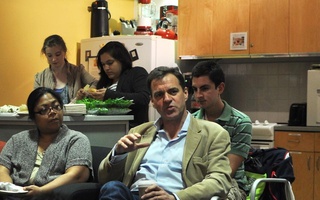(With apologies to The Globe and Mail’s Ivor Tossell.)
Stanford gets sunny days, to the point that you get bored of them. It’s a cliché. It’s also true. Back when I lived in New England, if there was a sunny day, you bet I was going to go out and enjoy it. At Stanford students spend sunny days inside studying.
Stanford gets In-n-Out Burger. Shut up. It’s better.
Stanford gets Skylar and Will. Their dramatic exploits will soon be detailed in Good Will Hunting 2: Hunting Season, where Will accuses the students of “regurgitating Elon Musk”, sees the light, and eventually joins the NSA.
Stanford gets Silicon Valley, the TV show.
Stanford also gets Silicon Valley, the actual place, which is generally considered a plus.
Stanford gets space, and it flaunts every inch of it. A mile will bring you all the way from the Charles to Radcliffe Quad, which for College students might as well be Mars. Stanford’s driveway is a mile long.
And Stanford gets the tools to conquer space. In these turbulent times, Fortress Stanford stands alone. The worst drought in a thousand years stops as soon as you get on campus. The entire world seems to fall away as soon as you cross Campus Drive.
Stanford also gets a number of incredibly important things that Harvard students have too, like world-class professors, a dominant alumni network, an eleven-figure hedge fund bankrolling every club you could ever imagine, and waffle irons that make waffles with the university logo on them.
Rightly or not, though, Stanford gets the nation’s lowest undergrad admission rate, which tends to swell people’s heads.
And isn’t our little war of admission rates at the heart of why this column matters? At the end of the day, you’re reading this because Stanford gets the (highly annoying) subtitle in American pop culture as “that plucky little school in Palo Alto that’s challenging Harvard to become number one.” All of this excruciating drama even though by Week 5 it is clear that your admission to any of these schools owes far more to luck than it ever could have to fate. Getting into Harvard/Stanford/[insert school here] is not a sign that you are God’s gift to mankind: it is your first lesson that the forces of destiny are blind.
And so the student at any of America’s great universities – not just Stanford or Harvard, but Berkeley or Rice or Michigan or Navy – shrugs off the idiocy of rankings and moves on with their lives. But the mind is not always rational, and in light of all the admittedly meaningful similarities that draw these schools together in the national mind, it still seems that for a lot of Harvard students, and vice versa, Stanford is a reflection in a smoky mirror – themselves, but through a glass, darkly.
The irony is that culturally, these schools have very little in common. They are both, of course, academically elitist. No one will ever accuse Stanford University or Harvard University of being down to earth. But if you must compare Stanford to an East Coast school, Stanford is not Harvard. Stanford is Duke. It may be 125 years old, but for a long while yet the defining difference between Stanford and its Ivy League cousins will still be that Stanford is self-evidently new money.
That, and the fact that Stanford gets Stanford.
Stanford gets the West, and all its transcendent glory. For all that students like to talk about how stressed they “secretly” feel, there is a certain joy to the University – a joy that can only come from living within an aura of infinite possibility. To be clear, the frontier is dead. We long ago realized that the New World was no longer new. But you learn very quickly here that today’s frontier is whatever you make of it.
The Ivy League schools all compel you to live in the shadow of the past. There is always someone to desperately chase. I actually think that’s a good thing in a way. It gives you a ready-made sense of pride, direction, and identity. It shows you that great people have passed through the same halls as you, and that someday you might be like them. But even though Campus Drive carries its own remarkable past, Stanford is still young enough that you can imagine doing something truly new. Everything about it is new. It’s an old university, but it’s never felt old to me. It doesn’t pretend to be fulfilled or complete. And when you bring in a bunch of young people who have never before failed and give them all the resources they need to succeed with no reason to hold back, you can see the birth of a brash confidence – constant, pulsating frissons of excitement that whatever we've accomplished is just the beginning. You can see a thousand dreams still in the making and a million worlds still unconquered.
As a high schooler in Massachusetts, I always felt out of place for wanting to go to Stanford. Harvard carries an almost religious quality for people in the Bay State, and to repudiate that dream still feels, five years later, like some act of unspeakable heresy against my adopted kind. People could barely conceptualize why I’d ever want to go so far away, but that was precisely because Stanford was a theater of dreams too wonderful to even imagine. And Stanford was, for want of a better word, unreal. This wasn’t always a good thing. I returned to Stanford a few months after graduation, and the truth is that yes, Stanford still feels like a welcoming fortress. I was reminded once again that I had spent four years in paradise. Stanford was heaven before its time. But life is imperfect, and Stanford’s insistent perfection creates a reality distortion field, in a way that not even the rest of the Bay Area can match. The campus was too gorgeous, the lawns were too neat, the sky was too blue. Even its timing was perfect. When I arrived in Palo Alto Stanford felt like the biggest, newest challenge in the world. Four years later, it feels disquietingly familiar – comforting, but a comfort zone nonetheless.
Stanford’s not a place where I could envision spending more than four years. But in a very real sense it is the greatest place on earth, and more importantly, a world I honestly miss.
Winston Shi is a current first-year at Harvard Law School, a two-time graduate of Stanford University, and a connoisseur of angry Harvard Crimson comment sections. His column appears on alternate Tuesdays.
Read more in Opinion
Yellow Love, Politics, and PoetryRecommended Articles
-
Women's Lacrosse Keeps Close with Stanford But Falls, 15-10Despite a big start to the second half, the Harvard women’s lacrosse team (3-4, 1-1 Ivy) dropped a game to a visiting Stanford squad (5-1) on Friday night.
-
 Historian Niall Ferguson Will Leave Harvard for Stanford
Historian Niall Ferguson Will Leave Harvard for Stanford -
Women's Squash Downs Stanford, 8-1The No. 1 Harvard women’s squash team brought the excitement and energy to the Murr Center in its season opener, defeating No. 9 Stanford, 8-1, for the 11th-straight time at the Boston Round-Robins.
-
 Women's Squash Opens Ivy League Slate by Sweeping Dartmouth
Women's Squash Opens Ivy League Slate by Sweeping Dartmouth -
Beware StanfordizationLet Stanford do what it may. Harvard should remain Harvard, a place where knowledge is valued primarily for its own sake, not for the new startups it spawns.













